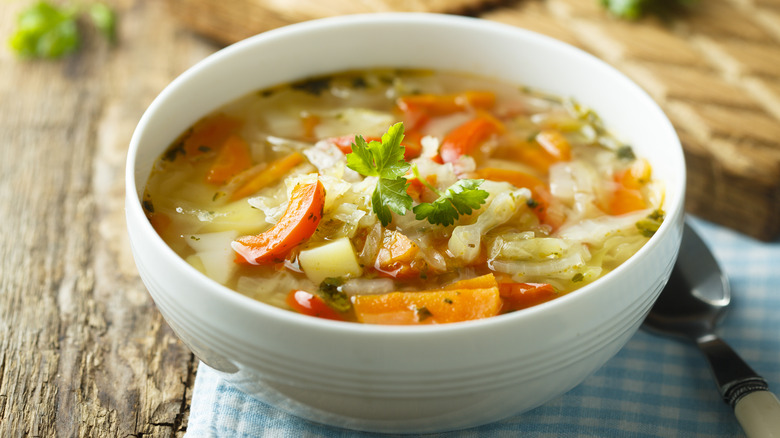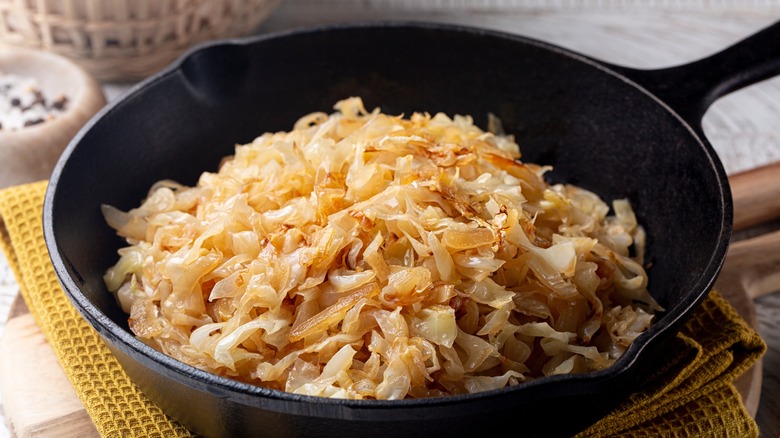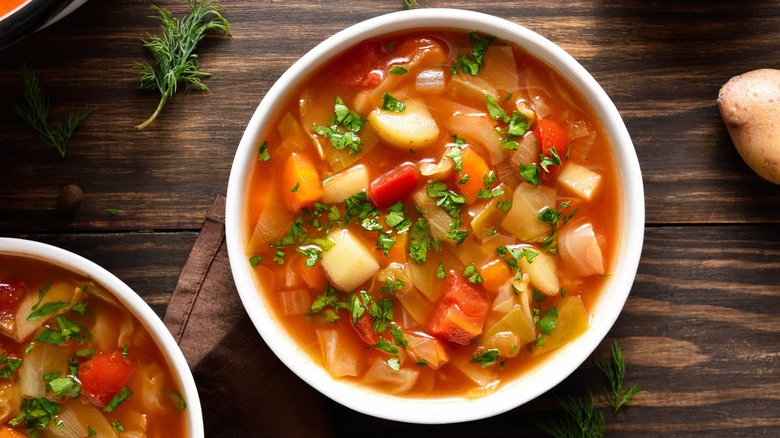One Simple Step Elevates The Flavor Of Cabbage Soup
Cabbage is one of the most versatile vegetables you can cook with, a star in everything from casseroles to coleslaw to chile crisp stir-fry. One of the easiest things to do with this hefty, leafy winter vegetable is to turn it into a cozy, warming soup. Whether cabbage soup was a childhood favorite of yours, or a dreaded way for your family to make the kids eat vegetables, it can be a rich, comforting classic at its best. To convert the cabbage soup-averse (including yourself) into forever fans, all you need to do is caramelize the cabbage first before proceeding with your recipe.
By caramelizing the cabbage leaves before making your soup, you bring the sweet undertones of the veggie to the surface, cutting down on unpleasant bitterness and making the cruciferous green more savory and sweet. It also cooks off some of the water in the cabbage, so you can kiss bland, waterlogged, boring soup goodbye (though we understand if you don't want to put your lips on it at all).
Just like making caramelized onions, this is a process that takes a bit of patience, but while you wait for the cabbage to turn a lovely golden brown, you have plenty of time to prep the ingredients for the rest of the soup. The flavor payoff is worth the wait.
Tips for caramelizing cabbage
If you simply slice up cabbage and let it boil in broth, you're in for a sulfury, smelly soup in no time. This is what makes cabbage so unappealing to some of us. You might think pre-cooking the veggie would only make it more soggy in the final soup, but cabbage is actually quite sturdy, making it perfectly suited to holding up to caramelization on the stovetop. Amongst the many varieties of cabbage, green or savoy cabbage are most often found in a cabbage soup recipe, and they create delicious results when caramelized.
To achieve the best results, you'll want to slice up the cabbage nice and thin, just like you would for caramelized onions or other ingredients (you could even caramelize onions together with the cabbage, for extra savory and sweet flavor in your soup). The slicing maximizes the surface area of the cabbage, as each shred can brown on all sides to form that appealing golden-brown color you're looking for.
Heat a pan over medium-high head, then add oil and the cabbage, plus a generous amount of salt. As your cabbage cooks down, make sure to pay attention to the brown bits crusting to the bottom of the pan. You'll want to add in a little liquid to the pan (like veggie stock, chicken stock, or water) to scrape those bits up and mix back into the cabbage, taking advantage of all that savory and browned flavor.
Complementing the caramelized cabbage in your soup
Once the cabbage has cooked down significantly and developed a golden-brown color, it's ready to go! This process should take about 45 minutes, if you're caramelizing a whole head of cabbage, but relying on visual cues and flavor is a better tell of when it's done. There's no harm in a little taste to make sure the sweet and nutty flavors have fully developed. Now you're ready to add the greens to your cabbage soup recipe as usual, but if you're up for more experimenting, try adding extra ingredients that play up the cabbage's sweetness even more.
If you've caramelized the onions with the cabbage already, you're one step closer to a delicious soup full of rich and complex flavors. Other veggies like chopped celery, bell peppers, or carrots always lend a hand, especially if you brown them before tossing them in the pot, as well. This unlocks their naturally sweet qualities. And bacon is always an excellent partner to cabbage, especially if you add chopped bacon to the pan to cook with the greens, caramelizing them in the rendered fat.
A bit of extra cooking will give you the most flavorful base possible for your soup. Once it all comes to a simmer in the pot, the hard work (and caramelization isn't actually hard) is over. Let the soup simmer to allow the flavors to meld, so that the broth absorbs all the luscious caramelized goodness from your sweet, golden-brown cabbage.


